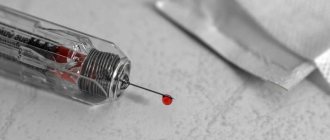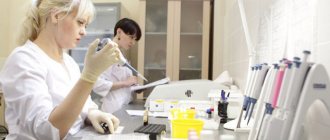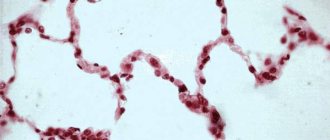At 6-12 weeks, a woman registers for pregnancy and immediately receives a referral from a gynecologist for a set of diagnostic measures. The doctor’s special “interest” is the results of urine and smear tests - these indicators are used to judge how the pregnancy is progressing as a whole and whether there is a threat of any complications for the expectant mother. In most cases, it is during urine examination that pathogenic E. coli is detected in the body. The mother and child suffer from the consequences of the disease, so it is important to detect the problem as early as possible and immediately begin treatment of the disease.
Escherichia - Escherichia coli - in the cervical canal
E. coli can normally be detected in stool cultures. We can talk about the development of pathology when it is detected in a smear of the vagina, cervical canal or urine culture. Most often, such a deviation from the norm indicates the development of a serious malfunction in the genitourinary and digestive systems. After determining the diagnosis, treatment must be started as soon as possible, otherwise the process may become chronic.
The danger lies in the resistance of Escherichia coli to various drugs, in particular to many antibiotics and compounds intended for the sanitation of the genital organs. Treatment of a lesion takes a long time, and achieving reliable results is not always possible.
Bacteria do not always pose a threat to the human body. Escherichia is directly involved in the formation of local immunity, therefore the disease is diagnosed when enterococci are detected in an atypical place in sufficient quantities. In such cases, pathological resistance of microorganisms to the immune response and a decrease in its activity are diagnosed.
Causes
It should be noted that minimal concentrations of E. coli in a smear go unnoticed, and traces of it cannot be detected. But if it is found, it means there are a lot of bacteria. This may be preceded by:
- poor genital hygiene;
- rare change of underwear;
- having sex on the beach, anal-vaginal contact;
- using other people's personal hygiene products - washcloths, towels, as well as wearing someone else's underwear.
If the analysis showed the presence of E. coli not only in the smear, but also in the urine, then the cause may be:
- anal sex between men, when the microbe penetrates the urethra;
- low level of acidity, urine pH;
- kidney disease, prostate adenoma, accompanied by rare urination;
- inflammation in nearby organs from which the infection spreads, for example, through the lymphogenous route;
- lack of hygiene;
- decreased immunity and hormonal changes during pregnancy.
Water from suspicious sources may well contain a whole range of microbes, just like products in dubious establishments.
A positive test result for E. coli can also be obtained when taking a swab from the pharynx (throat). It enters the human mouth along with dirty water or food, and is introduced into the soil, water bodies, vegetables and fruits with contaminated feces.
Reasons for the appearance of Escherichia in the vagina
The bacterium belongs to the group of opportunistic pathogens and is characteristic of the colon. It is directly involved in the processes of food decomposition and produces vitamin B and K. Like other pathogens, Escherichia is useful only in the large intestine; their detection in atypical places is dangerous.
The main reason for their presence in the vagina is the transfer of microorganisms from the lower part of the gastrointestinal tract. Detection of a pathogen in a smear of the cervical canal is not excluded. The risk of infection of a woman’s genital organs remains high due to the anatomical structure. Girls have a short urethra, it is located close to the vagina and anus, so the transfer of bacteria occurs frequently.
Escherichia is an aerobic bacterium that causes the development of an inflammatory process in the vagina. The microorganism actively reproduces in an atypical environment and leads to qualitative and quantitative distortion of the natural microflora. The main problem that appears against the background of such progress is the rapid decrease in the number of beneficial lactobacilli. Since they provide protection to the mucous membranes from pathogens, when creating a favorable basis, immunity decreases and the body’s resistance to various pathologies decreases.
Escherichia coli is often found in cervical smears in women during pregnancy. The basis for the pathological process is created against the background of hormonal changes characteristic of pregnant women. Against this background, the vaginal environment changes to alkaline.
The list of the main reasons that provoke the movement of E. coli into the vagina includes:
- anal sex;
- irregular change of linen;
- wearing underwear made of synthetic materials;
- insufficient hygiene of the external genitalia.
Anal sex is an indirect cause that can provoke infection. Much more often the reason is insufficient hygiene and wearing low-quality underwear. Infection in domestic conditions (through personal hygiene items) occurs quite rarely.
The most dangerous detection of Escherichia coli is in urine culture. This disorder indicates the development of an inflammatory process in the ureters, kidneys and bladder. The danger of the process lies in the rapid progress, against which destructive changes occur in the structure of the kidneys, leading to the development of renal failure.
How to prevent E. coli from entering the vagina during pregnancy
To prevent a harmful microorganism from penetrating into the genital cavity, it is important for a pregnant woman to remember a number of precautions:
- wash from the vagina to the anus - strictly in one direction;
- carry out genital hygiene after each bowel movement, using water and a special intimate gel for sensitive skin;
- give preference to seamless underwear made of natural fabric;
- do not wear thongs (at least during pregnancy);
- go to the toilet “little by little” before and after intimacy;
- avoid hypothermia;
- take multivitamin preparations (in consultation with your doctor);
- Drink prebiotics from time to time to improve and support the intestinal microflora.
Symptoms
The activity of a microorganism can be suspected by the following signs:
- constant itching and burning in the vagina;
- painful intercourse;
- difficulty urinating;
- slight discomfort (pain) in the pubic area;
- thick white or gray discharge that smells fishy.
With concomitant damage to the urinary system, other symptoms may occur: nausea, abdominal pain, vomiting and diarrhea. Such signs can also be traced due to the rapid increase in the number of bacteria and indicate intoxication of the body.
Diagnostics
The therapeutic intervention regimen is determined after receiving the results of a smear taken from the cervix. In order for the examination result to be accurate, it is important to comply with the following conditions:
- one day before the examination, exclude sexual intercourse;
- stop using vaginal tablets and suppositories for 2-3 days;
- On the day of the smear test, carry out the hygienic procedure without using soap or any cosmetic chemicals.
A smear for Escherichia is considered positive when E. coli is detected in the cervical canal, provided that a trend towards a decrease in the number of lactobacilli is detected.
Danger to pregnant women and fetuses
During pregnancy, the presence of pathogenic microorganisms and foreign bacteria in the vagina, cervical canal and other organs of the reproductive system is extremely dangerous. Treatment should be carried out in a gentle manner so as not to harm the fetus.
First of all, the sensitivity of E. coli to antibacterial drugs is determined. There is no need to stop using them. New products are absolutely safe for women and children, and E. coli can cause significant harm and disrupt the process of normal development of the fetus in the womb.
Prevention Tips
Tip #1
You should wash your genitals after urination, defecation and sexual intercourse. Moreover, it is important to do it correctly, and first wash the front part, and then move on to the anus. The reverse sequence can lead to the introduction of E. coli into the vagina.
Tip #2
It is undesirable to use scented toilet paper and sanitary pads, as they can cause irritation to the mucous membranes. And small wounds will become an excellent breeding ground for pathogens.
Tip #3
You can douche regularly only as prescribed by a doctor, since such procedures can disrupt the natural microflora, simply washing away beneficial bacteria from it.
Tip #4
Those who frequently change sexual partners may be advised to use barrier contraception, such as condoms.
Tip #4
The use of local drugs with applicators requires careful disinfection of the latter.
Tip #5
Thongs are “harmful” underwear, which is better replaced with regular cotton panties.
Prevention
The main role in the prevention of the initial and reappearance of the problem is played by intimate hygiene and compliance with the rules for ensuring it by the patient. For toileting the genitals, it is better to use special hygiene products or regular glycerin soap (without fragrances). Such compositions ensure the prevention of irritation and do not change the natural acid balance.
A fertile environment for the proliferation of pathogens are washcloths and sanitary sponges left by a woman after procedures in the bathroom. Moisture and heat are a positive environment for the growth of bacteria, so you should avoid using these accessories. When ensuring hygiene, you need to follow the basic rule - you need to wash your genitals from front to back. To remove moisture, use a special towel.
To reduce the risk of infection, it is necessary to wear underwear made of breathable fabrics and change it regularly. Avoid wearing tight clothing that interferes with natural air circulation. During the course of treatment, you must follow a drinking regime, drinking up to 2 liters of clean water per day. Sexual rest is necessary until complete recovery.
Escherichia enters the cervical canal from the rectum. The main cause of infection is insufficient hygiene and wearing underwear made of synthetic materials. A woman may not notice the problem for a long time and attribute it to recurrent candidiasis (thrush). The symptoms of such lesions are really similar. E. coli causes itching, irritation and redness around and inside the vagina.
All kinds of folk remedies in the fight against Escherichia are ineffective, because E. coli penetrates the epithelium quite deeply. Douching will not help restore the microflora; it can cause a woman’s well-being to deteriorate. The required course of therapy should be selected by the doctor based on the results of the examination.
Opportunistic bacteria Escherichia coli in a smear is a signal of a malfunction of the digestive or genitourinary system.
If such a symptom appears, antibiotic treatment should be started immediately. Medicines will help prevent the disease from becoming chronic.
What is E. coli during pregnancy?
In Latin, the name of the microorganism is Escherichia coli. These are bacteria that by their nature are divided into non-pathogenic and pathogenic. The “good” variety of E. coli populates the intestines, providing it with healthy microflora. “Bad” E. coli becomes the causative agent of severe infectious and inflammatory diseases. The human digestive, urinary and reproductive systems are usually chosen as targets.
Escherichia coli is a microorganism with “character”: the bacterium is stable enough to remain viable in water, soil and feces for several months in a row. The most fertile environment for bacteria to multiply is food, especially milk. Eating contaminated food is a guaranteed path to illness. The optimal temperature for bacteria to live is 37 degrees. Once in the body, it exists due to the consumption of minerals and amino acid breakdown products. When the immune system is weakened, it causes vaginitis, meningitis, and sepsis. In most cases, E. coli infection occurs due to simple failure to comply with hygiene rules.
Causes of Escherichia coli
Escherichia coli or Escherichia coli are rod-shaped bacteria that usually live in the intestines.
For various reasons, they are able to increase the territory of their habitat, populating, in addition to the intestines, the vagina and urinary tract.
E. coli can multiply in almost any human organ, since they only need a moist environment and a stable temperature to live.
Escherichia coli is present even in absolutely healthy vaginal microflora, but their growth and reproduction are inhibited by lactobacilli.
If lactobacilli disappear for some reason (for example, after treatment with antibiotics), then rapid proliferation of Escherichia coli begins, as well as other opportunistic microorganisms: candida, staphylococci, enterobacteria.
It is difficult to find Escherichia coli in a smear from the vagina and cervical canal, since the microbe forms colonies in the form of chains, which are mistakenly diagnosed as staphylococcal. It is easier to detect Escherichia coli in a smear culture.
Before taking a smear for culture, you need to prepare - wash your intimate organs with warm, clean water without soap or gel, and a few days before the test, give up alcohol.
Escherichia coli is resistant to the main types of antibiotics and antibacterial drugs. Treatment of E. coli in a smear is long and complex, and results are not always achieved.
One of the common reasons for the colonization of the vagina with E-coli is insufficient personal hygiene of the genitourinary organs.
You can become infected through sexual contact and through shared bath towels, washcloths, and underwear, but for this you need to have a weakened immune system: people with strong immune defenses cannot become infected with E. coli through household means.
Escherichia coli, having multiplied in the genitourinary tract, leads to the development of inflammation. In addition to smear culture, Escherichia coli can be detected in urine culture.
In this case, we can talk about an inflammatory process in the kidneys, ureters or bladder. Nephrological and urological infections are very dangerous, as they can cause kidney failure.
Norm and pathology
In a healthy person, Escherichia coli exists in the form of safe strains, the number of which varies between 106-108 CFU/g of contents of the lower parts of the colon. The level of Escherichia coli in other parts of the intestine should not be higher than 1%.
Escherichia coli is an opportunistic bacteria. This means that normally it is harmless and even brings benefits by participating in various metabolic processes. However, under the influence of certain factors, this microorganism can cause a number of coli infections due to different serotypes.
Important: The permissible amount of lactose-negative bacilli is no more than 105 CFU/g, and there should be no hemolytic bacilli at all.
Escherichia coli can be present in a woman’s vagina, but in an extremely limited amount, since its reproduction is normally restrained by lactobacilli - beneficial vaginal bacilli. When the level of the latter decreases, E. coli begins to quickly clone, and along with it the number of other microbes of opportunistic flora increases: staphylococci, Candida fungi, etc.
Symptoms of the disease
Infection of the vagina and urinary tract with E. coli is rarely asymptomatic.
Signs of infection of the genitourinary organs may include:
- painful, frequent and involuntary urination;
- loss of sexual desire;
- back discomfort;
- pain in the lower abdomen and groin;
- a feeling of weakness and fatigue, which indicates intoxication.
Without medical intervention, the growth of E. coli in the vagina and cervical canal will continue, and the health condition will worsen.
Over time, bacterial carriage enters the chronic stage, after which the patient’s quality of life is greatly reduced, as specific discomfort, itching, burning in the vagina and constant problems with urination appear.
E. coli can be exposed to the air for a long time without harm, so they can become infected through household means. Once in the genitourinary system, they find favorable conditions for reproduction there.
It is not easy to get rid of Escherichia coli in a smear; it is better to prevent infection of the vagina with E. coli.
To do this, you need to maintain personal and social hygiene:
- keep the intimate area clean;
- do not touch intimate parts with dirty hands;
- do not use other people’s things (razor, underwear, towel) for intimate hygiene;
- When having sexual intercourse with unverified partners, use condoms.
The rules are simple and well-known; compliance with them protects against many health problems.
Self-medicating Escherichia coli in a smear means wasting your time. After the first unpleasant symptoms of vaginal dysbiosis appear, you should immediately consult a gynecologist. The doctor will take a smear for culture and find out the causes of itching and burning.
Increased risk factors
To transform Escherichia coli into a representative of pathogenic intestinal flora, appropriate conditions are required. This may be a sharp drop in immunity due to frequent colds, acute respiratory infections or chronic diseases, after surgical interventions.
Important: Immune protection weakens after prolonged and aggressive antibacterial, chemotherapy and radiotherapy, with diabetes, allergies.
Activation of E. coli is also possible with frequent consumption of unwashed fruits, vegetables and herbs, improper or insufficient hygiene.
Treatment options
Treatment is prescribed strictly individually; before prescribing antibiotics, the doctor must check the sensitivity of microorganisms to the drug.
Recently, women whose smears revealed an excess amount of E. coli have no longer been prescribed antibiotics, as the microorganism has acquired resistance, forming resistant varieties and hybrids.
Treatment of E-coli in a smear should begin with the restoration of intestinal microflora. Having treated dysbiosis, you can at the same time get rid of Escherichia coli in a smear and urine without antibiotics.
To restore intestinal microflora, probiotics are used: Bifiform, Linex, Enterol, Trichopolum and others.
The doctor will choose the course individually, so you may need to change several medications. During treatment you will have to follow a diet.
It is forbidden to eat products obtained as a result of fermentation, fermentation and smoking. Beer, yeast dough, wine, pickled vegetables and even honey are prohibited. In other words, you will have to get rid of Escherichia coli in a smear with the help of not only a gynecologist, but also a gastroenterologist.
To treat Escherichia coli in a smear, it is not necessary to inject antibiotics; you can try to artificially populate the vagina with lactobacilli. You can restore normal vaginal flora with the help of Acilact, Vaginorm, Gynoflor suppositories.
You can fight microorganisms using the drug "Intesti-bacteriophage", which is a solution for rectal and vaginal administration and oral administration.
The medicine helps to get rid not only of vaginal dysbiosis, but also of disturbances in the balance of intestinal microflora, enterocolitis, colitis and even dysentery and salmonellosis. The product can be used even by children in the first months of life. The course of treatment is 7–10 days.
E. coli in a smear during pregnancy is especially dangerous, as it can lead to the development of cystitis, pyelonephritis and adnexitis.
Diseases of the genitourinary system in a pregnant woman are treated in a hospital. The doctor will prescribe antibiotics, which can be used without fear of harming the fetus.
Treatment of Escherichia coli in a smear should be continued until their level drops to normal levels and the symptoms of infection disappear.
This may take from several weeks to several months, because you will have to not only get rid of the infection in the genitourinary organs, but also restore the natural microflora.
Diseases resulting from vaginal dysbiosis, after entering the chronic stage, can lead to infertility.
Any woman who is found to have an excess of Escherichia coli in a smear should remember this danger and not neglect treatment.
Women's health requires a lot of attention: regular examinations by a gynecologist and tests, including a smear from the cervical canal for bacteriological examination. Bacterial culture from the cervical canal is a microscopic examination to determine opportunistic microflora and its sensitivity to antibacterial and antiseptic drugs.
Bacteriological culture from the cervical canal is a laboratory method for studying the microflora of the canal that connects the cervix and vagina. This flora smear is carried out when there is an increased level of white blood cells, which indicates possible inflammatory diseases of the woman’s genital organs, the causes of which may be bacteria, infections, or fungi.
In addition, microflora culture allows one to determine the resistance of pathogens to groups of antibacterial drugs. The data obtained during laboratory studies make it possible to correctly select medications on which recovery depends.
Diet during treatment
During the period of acute intestinal infection, adherence to a gentle diet is indicated. Fried, spicy, fatty foods, as well as pickled and canned foods are completely excluded from the patient's diet. Before recovery, you must give up dairy and fermented milk products, since milk sugar is an excellent nutrient medium for E. coli.
Fruits and vegetables should be consumed pureed or baked. This is necessary to prevent injury to the inflamed intestinal mucosa by coarse dietary fiber, which is contained in large quantities in this group of products.
Baked apples
The following dishes and products are also prohibited:
- seeds and nuts;
- carbonated drinks;
- chocolate and products containing cocoa butter;
- confectionery;
- alcohol;
- sausages;
- salo;
- butter;
- canned fish and meat.
Preservation for the period of treatment is prohibited
It is necessary to adhere to a gentle diet for at least 10 days.
Escherichia coli is a natural inhabitant of the human body, but if hygiene rules are not followed and the immune system is systemically weakened, infection with pathogenic strains of Escherichia coli is possible, which can cause severe diseases of the intestines and other internal organs. Prevention of infection consists of improving personal hygiene skills, proper food processing and strengthening the body's protective functions. Itching of the anus, you can find out at the link.
Indications and preparation
A bacterial culture from the cervical canal must be given to a woman:
- During an annual scheduled preventive examination with a gynecologist.
- At the stage of planning and preparation for pregnancy.
- If you suspect inflammatory processes in the cervix.
- If the flora smear contains cocci.
- A smear for flora with an increased level of leukocytes.
- In case of relapse of inflammation of the cervix and vagina.
In order to obtain reliable data, the culture tank from the cervical canal must be properly prepared for the delivery of biological material. To do this you need:
- The day before the test, avoid the use of local medications and douching.
- Avoid sexual intercourse 24 hours in advance.
- Take a smear for flora after colposcopy no earlier than 48 hours later.
- Conduct a bacteriological examination no earlier than 14 days after a course of antibacterial drugs.
Treatment of Escherichia coli
Many methods are used to treat bacteria in urine. Doctors start with more gentle ones. If no clinical symptoms are detected, the doctor will prescribe medications that strengthen the immune system.
If pronounced symptoms are observed, use antibacterial agents to which the pathogen is sensitive. At the same time, drugs are prescribed that improve the condition of the intestinal microflora.
If the disease occurs during pregnancy or in the children themselves, the doctor will recommend the use of bacteriophages. You can also take a test to determine the sensitivity of the microorganism to it.
Decoding indicators
The microflora of the female genital organs is not sterile, but already contains lactobacilli and bifidobacteria, the norm of which should not exceed 107. In the process of studying the flora, it is important to determine the type of pathogenic microorganisms:
- Escherichia coli (Escherichia coli).
- Enterococcus.
- Staphylococcus and its varieties.
- Citrobacter.
- Proteus.
- Gardnerella.
- Trichomonas.
- Gonococcus.
- Leptothrix.
- Fungal microorganisms.
E. coli present in the microflora of female genital organs within normal limits does not cause harm to female sexual health. If the indicator is exceeded, it indicates the presence of inflammatory processes and is an indication for antibacterial treatment. Treatment with antibiotics is also necessary for women whose flora smear shows the presence of one or more units of staphylococcus, gonococcus, trichomonas and others.
A tank culture for ureaplasma, mycoplasma, and chlamydia will not show the presence of the listed intracellular parasites. For this purpose, polymerase chain reaction (PCR) of microflora is prescribed.
Moreover, regardless of the pathogens that were identified during the bacteriological study, they all go through the same stages of development. Decoding the result is based on this data.
Stage 1 - cocci and other pathological microorganisms are in the process of slow growth in a liquid medium.
Stage 2 - bacterial reproduction occurs on a hard surface, no more than 10 colonies.
Stage 3 - cocci are able to multiply from 10 to 100 colonies, which indicates the presence of an inflammatory disease.
Stage 4 - the number of bacteria is more than 100 on solid habitats.
Detected E. coli, staphylococcus in the cervical canal and other infections can be a consequence of:
- metabolic disorders in the body;
- weakening of the body's immune forces;
- non-compliance with hygiene standards;
- hormonal imbalance;
- inflammatory diseases of other organs of the genitourinary system;
- hereditary pathology.
Escherichia coli e coli in the urine of a child
E. coli passes into the baby's gastrointestinal tract immediately after birth and persists for life. E coli in the urine of children appears due to a weak immune reaction caused by this microorganism during inflammation of the genitourinary tract. After the microbe enters the urethra, it moves upward and sticks to the mucous membrane. Young children often do not complain of pain, so parents do not notice the symptoms and the stick gets inside the bladder and kidneys.
The main symptoms of the presence of E. coli in the urine of children, which will help alert parents to the disease:
- complaints of abdominal pain, crying during urination;
- frequent increase in body temperature to subfebrile values (37 – 37.5) for no apparent reason;
- the frequency of going to the toilet increases;
- the urine becomes cloudy and an unusual odor appears.
Pathology of E. coli in infants
This condition is the most dangerous because parents do not notice the symptoms. Escherichia coli is detected in an infant during a preventative test.
In this case, doctors prescribe a more gentle treatment, without the use of antibiotics, so as not to harm the health of the newborn.
Study during pregnancy
A culture from the cervical canal during pregnancy is a necessary study, the timely implementation of which will help protect the expectant mother and child from serious complications. First of all, an untreated infection can cause premature birth. This is due to the negative impact of pathogenic microflora on the plug, which softens and can come off already in the second trimester of pregnancy.
If a pregnant woman managed to maintain her pregnancy, cocci and other infections detected in a smear of the cervical canal can cause disturbances in the process of intrauterine development of the fetus and lead to mutations or the birth of a child with abnormalities. Infection can occur after the plug comes out or during passage through the birth canal.
In connection with the above, it is important for a pregnant woman to be tested for bacterial culture of the microflora of the cervical canal. Taking biological material does not harm the fetus, since it is protected by a plug located at the entrance to the uterus.
Bacteriological seeding of the microflora of the cervical canal is carried out in case of an increased number of leukocytes, a planned annual examination, or pregnancy. The analysis allows you to determine pathogenic microflora and its sensitivity to antibiotics. Escherichia coli in a smear in small quantities does not cause harm; cocci and other infections indicate inflammatory processes in the cervix.
Escherichia coli in urine during pregnancy
During pregnancy, the fetus puts pressure on neighboring organs. This leads to the fact that during urination not the entire volume of urine is released. In the remaining urine, bacteria grow and develop in pregnant women, so starting from the 1st trimester, urine tests are performed for bacterial culture. This is fraught with kidney disease (pyelonephritis), inflammation of the bladder, urethra (cystitis) and vagina (vaginitis). The latter option is dangerous because during childbirth the child will become infected with the escherichia bacillus from the vaginal walls.
In critical situations, there is a risk of developing the following conditions:
- intrauterine infection;
- development of congenital malformations;
- poor functioning of the placenta;
- spontaneous miscarriage;
- intrauterine growth retardation;
- defects, diseases that appear immediately after birth.











